Guitar chords are created using the same theoretical principles as the piano, which means it’s easy to transfer them over. While chords are created using the same principles, ultimately, they’re quite a bit different due to the construction of both instruments, specifically, the way in which the notes are mapped out on each instrument.
That said, once you’ve figured out the fundamentals of intervals, key signatures, and major and minor scales, the mystery of why chords are the way they are fades away. But let’s say that you wanted to take a guitar chord and then play it on the piano. What would be the best way for this?
When you play a C chord on a piano, it’s composed of three distinct notes: C, E, and G. Similarly, playing a C chord on a guitar involves the same three notes, but in a different order. From the lowest to the highest pitch, the order of the notes for a C chord on the guitar is E, C, E, G, C, E.
To use guitar chords on the piano, first identify the notes of the guitar chord including the root, third, and the 5th. Using C Major as an example, the chord is comprised of C, E and G. Find those notes on the piano and play them together while understanding that black keys are always accidentals and white keys are always natural.
In this article, I’m going to show you how to convert guitar chords you know and love to the piano, in addition, to explaining some of the theories behind it in a user-friendly way. I’ll explain how to convert guitar chords into piano chords, and then we’ll discuss the foundational principles that way you have a better understanding of what we did.
How To Convert Guitar Chords To The Piano
The most important thing right away is to actually know the notes of the guitar chord. They are typically triads, however, by no means are they always just using 3 notes.
For this section, I’m going to show you how to convert two different types of guitar chords for the piano.
1 will be a simple triad, and the 2nd will be a more sophisticated chord, just to give you an idea of how this process works and why it’s so great. What you want to do, is the following:
1) Figure Out The Notes of the Chord
Standard Triad
G Major (I (first chord) of the G Major Scale)
G, B, D
The G Major chord comes in a variety of different flavours on the guitar, but we’re going to do, is use the most common utilization of the chord, the G Major chord in the first position, which looks a lot like what you can see in the image below:
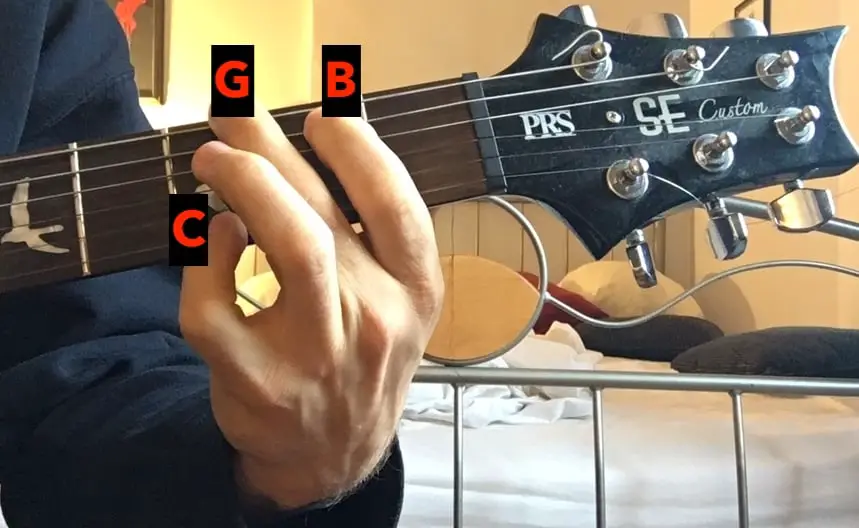
The first position G Major chord consists of the following notes:
G, B, D, G, B, G
Low E-string G on the 3rd Fret
A-String B on the 2nd Fret
Open D-String
Open G-String
Open B-String
High E-string on the 3rd Fret.
As you can see, the G Major chord consists of three notes, two of which are actually repeated at different octaves:
The G and B
2) Apply Those Same Exact Notes to the Piano
How To Play the G Major On The Piano
As I said above, the amazing thing about the piano is the fact the notes repeat themselves in the exact same way up and down the keys.
The white notes of the piano look like the following:
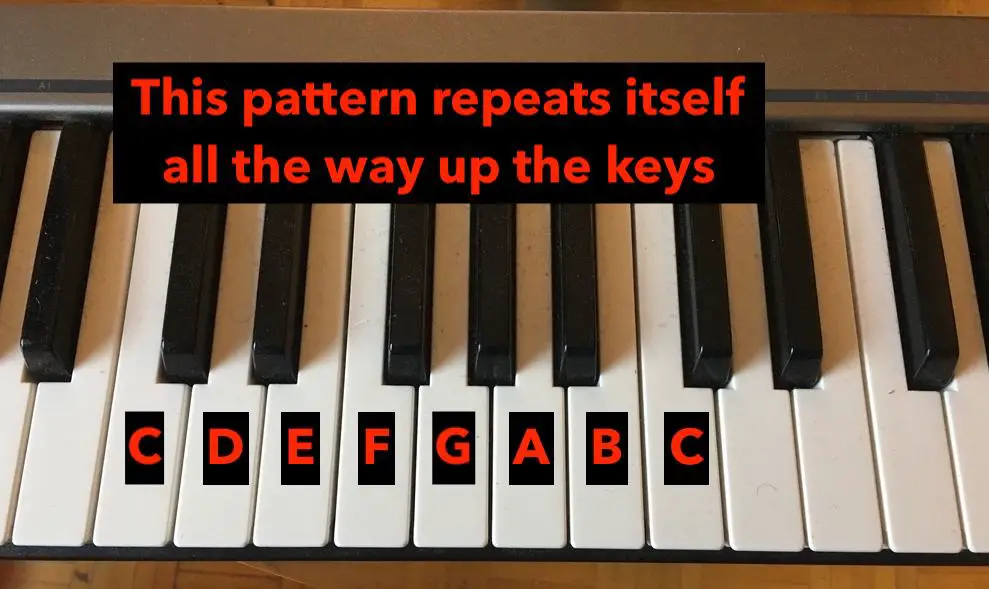
The black notes of the piano look like the following:
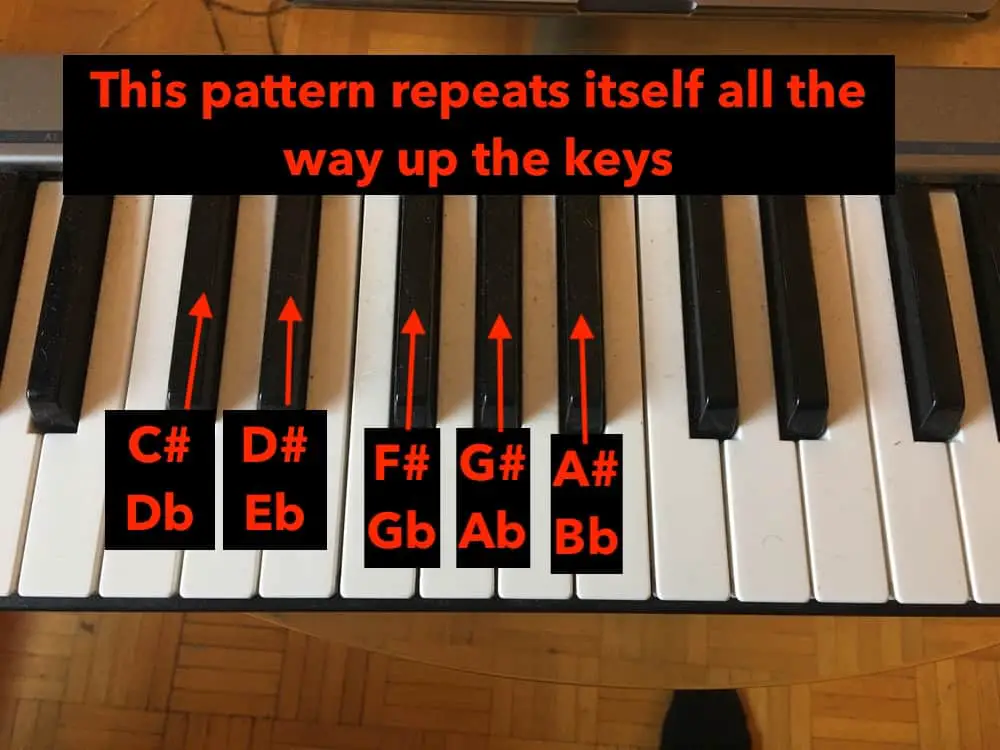
Now, the notes are simply played in the exact same way up and down the keyboard. That’s what makes the piano so amazing to play. It’s easy to understand right off the bat.
So here is what the exact same chord G Major chord looks like on the Piano, using the information that I just laid out for you above:
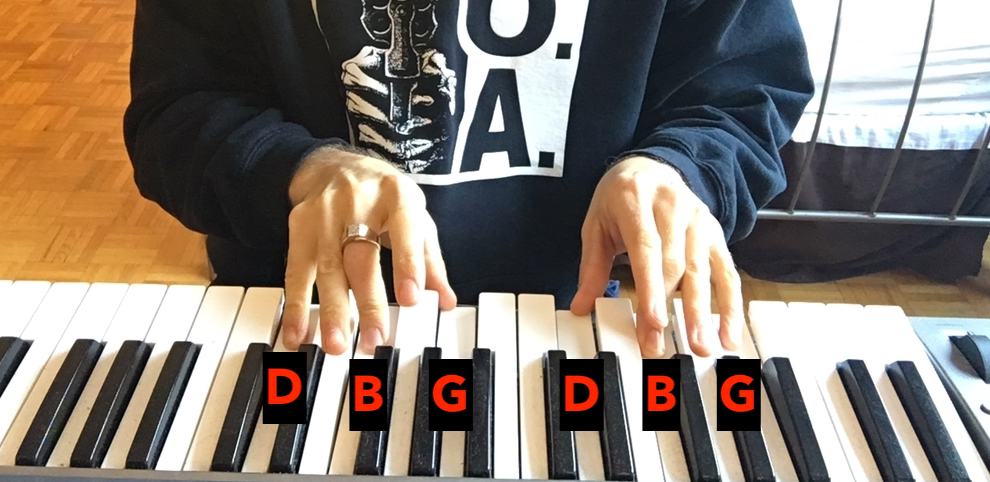
And that’s exactly how it’s done.
For this next section, I’m going to show you how to play a more complicated chord from the guitar on the piano:
Extended Chord
DMaj7#11
This chord consists of the following notes on the guitar:
D, D, F#, (A), G#, C#
Essentially, what it is, is a Major 7th chord with an added #11, which means you just have to count up from the root note, D, all the way up until 11, and then once you get there, you sharp that 11th note.
And what you get are the notes laid out above.
On the guitar, it looks a lot like what you can see in the image below:
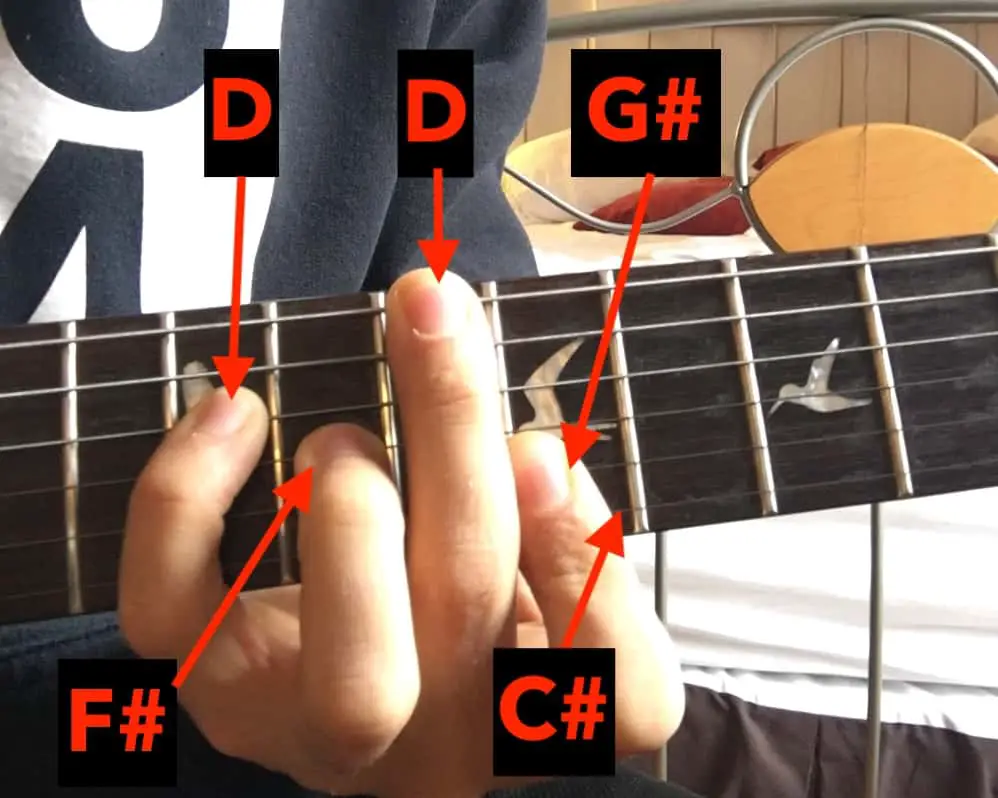
Your second figure on the fretting hand is on the low E-string (D),
Your fourth finger is on the 12th fret of the D string (D),
Then your third finger is on the 11th fret of the G-string (F#),

And then you use your first finger to bar the 9th fret on both the B-string (G#) and the high E-string (C#).
You’ll notice there is one note missing from the chord, the A, but it’s not entirely necessary to have it in there. However, you could find an alternate voicing of the same chord which does include the A-note.
Once you’ve figured out what notes are being used to make up the chord, you can jot them down on a piece of paper, or write them down in your computer’s notebook, and then transfer each note over to the piano, using both your left and right hand.
So here is what the DMaj7#11 looks like on the piano:
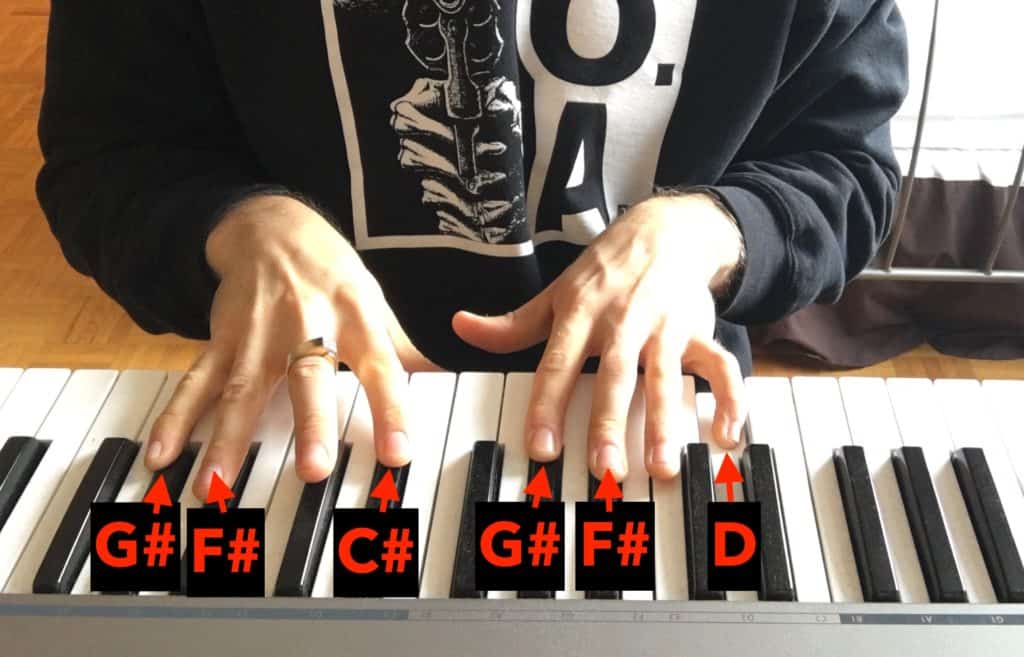
As you can see, it’s really not that complicated to transfer notes from the guitar over to the piano.
All you have to do is figure out the notes of the chord on the guitar; understand what keys are what notes on the keyboard/piano, and then simply play them.
Now that I’ve shown you how to transfer the guitar chords over to the piano, let’s talk about some of the foundational principles you have to know for chord construction.
For added measure, I also threw in the Dmaj7#11 chord with the A note included, which you can see in the image below:
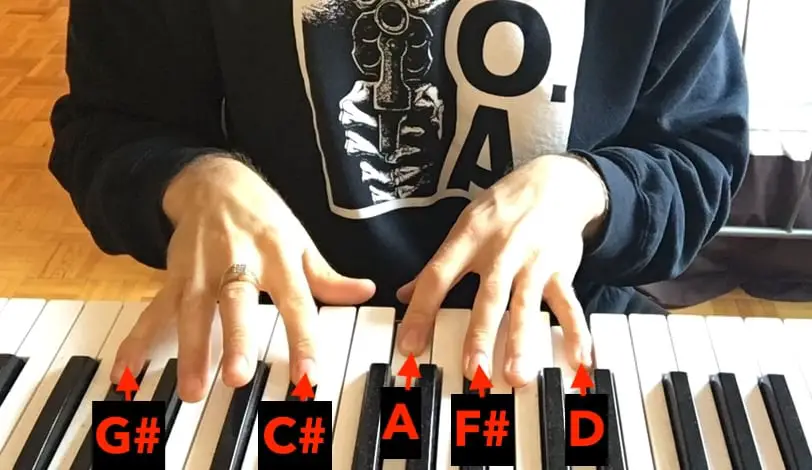
What Is A Triad On The Guitar And Piano?
The foundational idea on which chords are based is called the “triad,” which is a chord consisting of the Root, the Third, and the Fifth. I’ve talked about this in a few articles already, but it’s important to understand what a triad is because it’s the foundation of every chord in Western music theory.
A chord is made up of the aforementioned intervals, the root, third, and fifth, and these intervals consist of a variety of different flavors. These are the following intervals: major, minor, augmented, diminished, perfect, and unison/octave.
Each interval has its own characteristic sound and style and depending on what interval the chord utilizes in conjunction with another, the sound of it changes quite dramatically. Using the Key of C Major, for instance, we’re going to briefly outline how to construct the chords of the Major Scale using basic triads.
These are the roman numerals comprising the major scale, and each roman numeral has a different meaning.
I = Major
i = Minor
iiiø = Diminished. Anytime you see the minor roman numerals with a little zero next to it, it signifies diminished.
III+ = Major roman numerals with a (+) sign beside it always means augmented.
V7 = Roman numerals with a (7) tacked on always means that it’s a 7th chord.
So here are the following scale degrees of the C Major Scale.
I – Major
ii – Minor
iii – Minor
IV – Major
V – Major (Dom 7)
vi – Minor
viiø – Half-diminished
The notes of the C Major scale are the following, C, D, E, F, G, A, and B
Notice the fact that the notes of the major scale have the same number as the scale degrees?
Building triads is ultimately a very simple and uncomplicated process. You just take every other note of the scale to create a triad.
So here are the notes and chords of the C Major Scale, as well as the tonality of each one:
I – C Major
ii – D Minor
iii – E Minor
IV – F Major
V – G Major (Dom 7)
vi – A Minor
viiø – B Half-diminished
How Are The Chords Built On Piano and Guitar?
To build triads, as I mentioned above, you simply take every other note and build the chord with it.
To make the first chord, C Major, you take the C, E, and G from the C Major scale.
C, D, E, F, G, A, B, and C
C, E, G – C Major – I
To build the D Minor, you do the same thing, except you start on a different note.
C, D, E, F, G, A, B, and C
D, F, A – D Minor – ii
To build the E Minor, you again, do the exact same thing, except you start on the E, instead.
C, D, E, F, G, A, B, and C
E, G, and B – E Minor – iii
And you just continue on and on with this process until you’ve constructed every chord in the scale.
This is the basic idea one has to understand to truly grasp the use of chords.
Once you understand this foundational principle, it’s easy to take it one step further and start adding additional notes to the triad, which adds an entirely different sound in many cases, either creating new tonal qualities or changing the sound of the chord completely.
For instance, if you add an F, to the G Major chord in the C Major Scale, you get the Dominant 7th, which is basically what’s known as the G7 chord.
It uses a few different intervals:
Major Third, Perfect Fifth, and the Minor 7th
This is the chord that’s used a lot in blues, for instance, in the 12-bar blues progression, it utilizes many chord changes to the Dominant Seventh chord.
If you change the note to an F#, you end up with the following intervals:
Major Third, Perfect Fifth, Major 7th
Which is actually the Major 7th chord.
Just changing the tonality of the last interval, the last note of the chord, you wind up with a completely different chord.
And one can go on and on with this. You can add all kinds of notes and all kinds of intervallic relationships and end up with something either totally bizarre or totally beautiful, depending on what intervals you use and for what purpose.
So bringing this all back together for the sake of applying guitar chords to the piano, you just have to understand the basic idea of how notes on the piano are mapped out.
Thankfully, the piano is perhaps the instrument that’s the most conducive to understanding music theory principles, which is one of the reasons why it’s commonly used as the instrument for beginning students to music.
Additionally, it utilizes the bass as well as the treble clef, which means that piano players know how to use both clefs, which will ultimately come into good use later in life, assuming the piano player decides to learn another instrument.
In fact, one of the greatest guitar players of all time, Shawn Lane, was an unbelievably good pianist. There are videos of him online absolutely shredding the piano as well as the guitar.

Other Articles You May Be Interested In
- What Are the Most Beautiful Guitar Chords? [ANSWERED]
- What Guitar Chords Are Sad? [With Examples & Explanation]
- Why Is It Important To Learn Chords on Guitar? [SIMPLE]
- Tuning A Guitar With the Piano (Altered Tunings Included)
- How Guitar Chords Are Named And Why

 Written By :
Written By :
